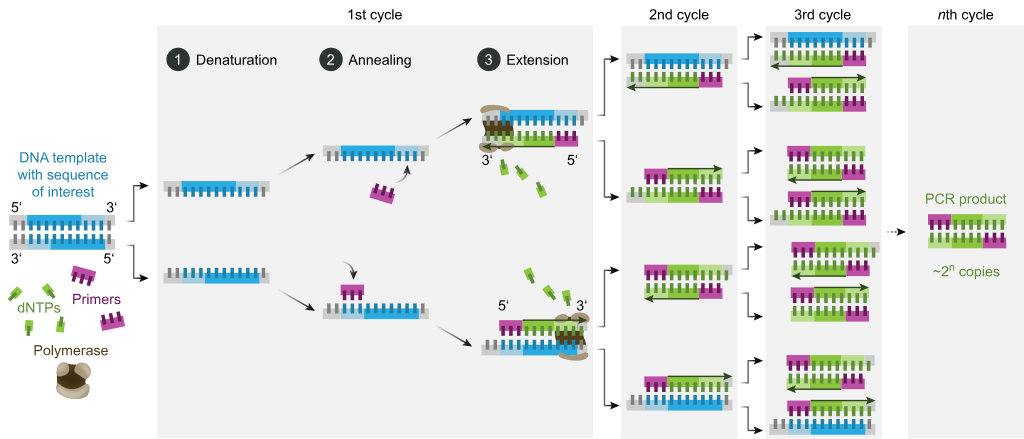
In the last article I ended with a DNA fragment, that I created with a PCR. Now I need to get this DNA into my yeast cells to teach them to age like normal people. This is called transformation. There are several different transformation techniques but most common are elctroporation and chemical transformation. You can spark emotional debates if you ask what is better but the more common and generally a bit easier is the chemical transformation. That is also the method I chose for my aging yeast.
How transformation works mechanistically is not completely understood but the main idea is that you have to overcome the barriers protecting cells from their surroundings. These barriers are the cell wall (for all except animal cells who don’t have one) and the cell membrane. The cell wall’s main responsibility is mechanical stability. You can imagine it like a steel frame that prevents the membrane, which you can imagine like a water bomb, from swelling too much until it bursts. On a molecular level it is a relatively wide net, so it’s not a physical barrier for the DNA molecules. What’s problematic however is that it is electrically charged. DNA is negatively charged and would be repelled from the mostly also negatively charged molecules in the cell wall. This obstacle is overcome by adding positively charged ions that neutralize the charges of the cell wall and allow the DNA to get close to the cell’s membrane.

But than it has another problem which is the cell membrane. The membrane is a double layer of lipids, fat molecules that have a polar and an uncharged tail. This structure is something like a 2-dimensional liquid. It is relatively elastic and allows uncharged molecules that are not too big to path quite well. Since DNA is huge and strongly charged it normally won’t pass easily. To pass this barrier you have to torture your yeast a bit (*laughs manically in evil scientist). You submit them to a sudden increase of temperature to 42 °C from room temperature. Doesn’t sound too bad but yeast likes it best between 20 and 30 °C above 40 °C starts killing them slowly. This is thought to built differences in pressure between the hot outside and cool inside of the cell which is equalized by the formation of pores in the membrane. Through these pores the DNA can now enter the cell.
To avoid another line of defense of the cells which is enzymes that eat DNA, you also add some carrier DNA, which will be eaten first and so protects the DNA you want to get into the cells. As carrier DNA you normally use Salmon Sperm that you boil and then add to the mix. So if you hear molecular biologists talk about cooking some sperm it’s probably not as weird as it might sound.
After overcoming the defenses you now have a lot of dead cells, many that have taken up nothing or only the carrier DNA but you hopefully also have some that have the DNA that you wanted to introduce into them. What happens with this DNA depends on its form. If it is a closed circle and includes some special signals in the code it will be just kept in the cell and will be copied to the daughter cells when the cell replicates. This is called a plasmid and is good if you just want to introduce genes more transiently without permanently changing the genome. If the DNA (like in my case) is a linear open molecule produced by PCR and has ends that resemble a sequence in the genome of the yeast, it can go into the nucleus of the cell, where the genome is kept. There it can jump in while the cell replicates and integrate permanently into the genome.
Now you have to filter for those cells where this has worked from the rest. You do this with selection. You seed your cells to a medium where only those cells can grow that have taken up your DNA. This is done by adding a marker to the DNA which is a gene that either makes your cells resistant to something that is poisonous to the others or that let’s them live of a food source that the others can’t use. I used cells that normally can’t make Uracil (which is a part of DNA) themselves so they can’t grow on medium where there is no Uracil. They only can grow on this medium if they have taken up my construct which includes a gene that helps them make their own Uracil.
The problem is that this integration is very rare. You start with a huge amount of cells, transform them seed them all to the selection plate and sometimes get nothing, sometimes one or two colonies but sometimes, if you’re lucky, you also get something like 100.

To verify that the construct is really integrated where I hoped it would, I now need another PCR. I chose primers that normally produce a short fragment of DNA from the region where I want to integrate my construct. If it is successfully integrated the fragment gets longer which I can see in a gel electrophoresis. And that is what I’m currently doing. I’ll soon give you an update when I’ve finally found my aging yeast.














